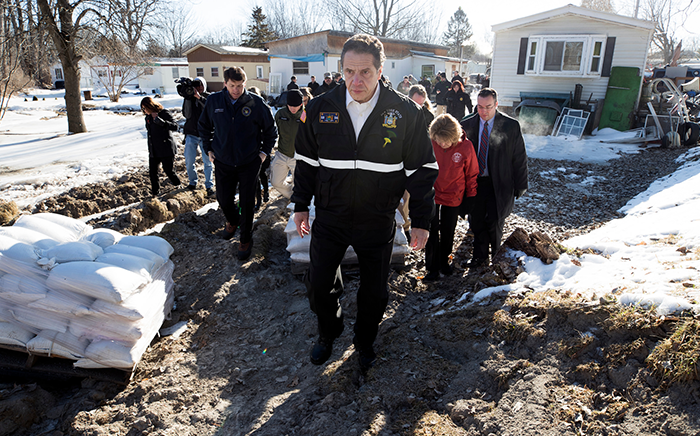Photo Courtesy of Mike Groll/Office of the Governor
Cuomo last month surveyed damage at Underwood Estates Mobile Home Park after flooding caused by ice jams on the Saranac River destroyed homes and displaced residents.
By Michael V. Cusenza
Governor Andrew Cuomo on Monday urged New Yorkers who live in coastal areas and along streams and rivers – including Hamilton Beach, Broad Channel, and parts of Howard Beach – to take precautions against the effects of potential ice jams in the wake of unseasonably warmer temperatures and heavy rain this week.
According to the U.S. Army Corps of Engineers, an ice jam is an accumulation of ice at a given location which, in a river, restricts the flow of water. The National Weather Service notes that ice jams can develop near river bends, mouths of tributaries, points where the river slope decreases, downstream of dams and upstream of bridges or obstructions. The water that is held back may cause flooding or flash flooding upstream. If the obstruction suddenly breaks, then flash flooding may occur downstream.
Cuomo pointed out that the combination of warm temperatures, some rainfall, and snowmelt could lead to ice jam movement and possible ice jam flooding.
“Given this week’s weather forecast, I have directed State agencies to prepare for conditions that could increase the flooding risk statewide,” the governor said. “I urge anyone living…in areas that have experienced previous flooding, to pay close attention to weather reports and stay safe.”
The State also provided some flood-preparation safety tips:
• Learn the safest route from your home or business to high, safe ground should you have to leave in a hurry.
• Develop and practice a “family escape” plan and identify a meeting place if family members become separated.
• Make an itemized list – as well as potentially photo and video documentation – of all valuables including furnishings, clothing and other personal property. Keep the list in a safe place.
• Stockpile emergency supplies of canned food, medicine and first aid supplies and drinking water. Store drinking water in clean, closed containers.
• Plan what to do with your pets.
• Have a portable radio, flashlights, extra batteries and emergency cooking equipment available.
• Keep your automobile fueled. If electric power is cut off, gasoline stations may not be able to pump fuel for several days. Have a small disaster supply kit in the trunk of your car.
• Find out how many feet your property is above and below possible flood levels. When predicted flood levels are broadcast, you can determine if you may be flooded.
• Keep materials like sandbags, plywood, plastic sheeting and lumber handy for emergency water-proofing.
• Check on your insurance coverage. Homeowners’ insurance policies generally do not cover flood damages. Only flood insurance can protect your home against flood damages. You can purchase flood insurance whether or not you live in a mapped flood zone.
In December 2016, legislation crafted by U.S. Reps. Grace Meng (D-Flushing) and Elise Stefanik (R-Upstate N.Y.) to help combat flood damage caused by ice jams was signed into law by President Barack Obama. The measure, part of the Water Infrastructure Improvements for the Nation Act that funds water-related projects throughout the country, would permit the Army Corps of Engineers to pursue new projects and technologies that are designed to prevent and mitigate flood damage associated with ice jams.

